
132 Results

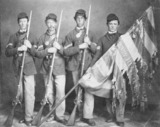
"The American Civil War, the bloodiest in the nation’s history, resulted in approximately 750,000 deaths. The war touched the life of nearly every American as military mobilization reached levels never seen before or since... The Civil War was a defining event in the history of the United States and, for the Americans thrust into it, a wrenching one." -The American Yawp, Chap. 14 Introduction[Image: 23rd Ohio Volunteer Infantry Color Guard - Ohio History Connection]
- Material Type:
- Module
- Author:
- OER Librarian
- Date Added:
- 05/07/2021

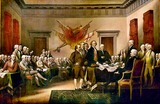
By the 1770s, Great Britain ruled a vast empire, with its American colonies producing useful raw materials and profitably consuming British goods. From Britain’s perspective, it was inconceivable that the colonies would wage a successful war for independence; in 1776, they appeared weak and disorganized, no match for the Empire. Yet, although the Revolutionary War did indeed drag on for eight years, in 1783, the thirteen colonies, now the United States, ultimately prevailed against the British. The Revolution succeeded because colonists from diverse economic and social backgrounds united in their opposition to Great Britain. Although thousands of colonists remained loyal to the crown and many others preferred to remain neutral, a sense of community against a common enemy prevailed among Patriots.
- Material Type:
- Module
- Author:
- OER Librarian
- Date Added:
- 05/07/2021

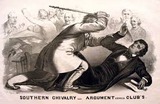
With the war with Mexico ending in the Treaty of Guadalupe Hidalgo, the entire country saw an opportunity to expand into this new territory. However, should this new territory be slave or free? The South wanted new soil for cotton and tobacco, which would require slavery. Northerners saw economic opportunities in the creation of farmland to relieve the overcrowding in the East. The Compromise of 1850 was thought to quiet the debate, but new crisis drove the wedge between North and South deeper and deeper. Finally, with the election of Lincoln in 1860, the South seceded.
- Material Type:
- Module
- Author:
- OER Librarian
- Date Added:
- 05/07/2021
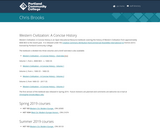
A three-volume textbook covering the history of Western Civilization from c. 8000 BCE to the recent past. Written to be compatible with most existing Western Civilization courses at American colleges and universities, Western Civilization: A Concise History rejects the triumphalist narrative of western progress while still providing an essential overview of the histories of the ancient Mediterranean, Europe, and the global connections of the modern era. The first edition was released in spring, 2019, and further revisions are planned by the author.
- Subject:
- Ancient History
- History
- World History
- Material Type:
- Textbook
- Provider:
- Portland Community College
- Author:
- Christopher Brooks
- Date Added:
- 05/22/2019

History 116, the first part of the introductory surveys of Western Civilization. This course covers the period from early civilized man to the early Middle Ages of Europe, with emphasis on Greece, Rome, Egypt and other Mediterranean peoples.
- Subject:
- History
- World History
- Material Type:
- Assessment
- Full Course
- Reading
- Syllabus
- Provider:
- Washington State Board for Community & Technical Colleges
- Provider Set:
- Open Course Library
- Date Added:
- 05/22/2019
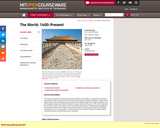
This course surveys the increasing interaction between communities, as the barrier of distance succumbed to both curiosity and new transport technologies. It explores Western Europe and the United States' rise to world dominance, as well as the great divergence in material, political, and technological development between Western Europe and East Asia post–1750, and its impact on the rest of the world. It examines a series of evolving relationships, including human beings and their physical environment; religious and political systems; and sub-groups within communities, sorted by race, class, and gender. It introduces historical and other interpretive methodologies using both primary and secondary source materials.
- Subject:
- Arts and Humanities
- History
- World History
- Material Type:
- Full Course
- Provider:
- M.I.T.
- Provider Set:
- M.I.T. OpenCourseWare
- Author:
- Anne McCants
- Jeffrey S. Ravel
- Date Added:
- 01/01/2014

History 126 is the first term of a three-quarter sequence on World Civilizations. The three courses may be taken in any order, but it is preferable to take 126 first. This course begins with a look at pre-historical societies, including early urban settlements, moving through the early histories of Mesopotamia, Egypt, India, and China, to a consideration of Hebrew, Greek, Roman and early Christian history. The Celts will be examined and then a study of the barbarian societies that helped cause the fall of the Western Roman Empire. Students of History 126 will increase their understanding of the religious, political, military, social, scientific, intellectual and cultural structures of world societies.
- Subject:
- Ancient History
- History
- Material Type:
- Assessment
- Full Course
- Reading
- Syllabus
- Provider:
- Washington State Board for Community & Technical Colleges
- Provider Set:
- Open Course Library
- Date Added:
- 05/22/2019
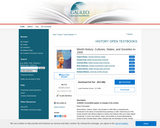
World History: Cultures, States, and Societies to 1500 offers a comprehensive introduction to the history of humankind from prehistory to 1500. Authored by six USG faculty members with advance degrees in History, this textbook offers up-to-date original scholarship. It covers such cultures, states, and societies as Ancient Mesopotamia, Ancient Israel, Dynastic Egypt, India’s Classical Age, the Dynasties of China, Archaic Greece, the Roman Empire, Islam, Medieval Africa, the Americas, and the Khanates of Central Asia.
It includes 350 high-quality images and maps, chronologies, and learning questions to help guide student learning. Its digital nature allows students to follow links to applicable sources and videos, expanding their educational experience beyond the textbook. It provides a new and free alternative to traditional textbooks, making World History an invaluable resource in our modern age of technology and advancement.
- Subject:
- Ancient History
- History
- World History
- Material Type:
- Textbook
- Provider:
- University System of Georgia
- Provider Set:
- Galileo Open Learning Materials
- Author:
- Andrew Reeves
- Brian Parkinson
- Charlotte Miller
- Eugene Berger
- George Israel
- Nadejda Williams
- Date Added:
- 09/22/2016
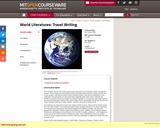
"This semester, we will read writing about travel and place from Columbus's Diario through the present. Travel writing has some special features that will shape both the content and the work for this subject: reflecting the point of view, narrative choices, and style of individuals, it also responds to the pressures of a real world only marginally under their control. Whether the traveler is a curious tourist, the leader of a national expedition, or a starving, half-naked survivor, the encounter with place shapes what travel writing can be. Accordingly, we will pay attention not only to narrative texts but to maps, objects, archives, and facts of various kinds. Our materials are organized around three regions: North America, Africa and the Atlantic world, the Arctic and Antarctic. The historical scope of these readings will allow us to know something not only about the experiences and writing strategies of individual travelers, but about the progressive integration of these regions into global economic, political, and knowledge systems. Whether we are looking at the production of an Inuit film for global audiences, or the mapping of a route across the North American continent by water, these materials do more than simply record or narrate experiences and territories: they also participate in shaping the world and what it means to us. Authors will include Olaudah Equiano, Caryl Philips, Claude L?vi-Strauss, Joseph Conrad, Jamaica Kincaid, William Least Heat Moon, Louise Erdrich, ?lvar N
- Subject:
- Arts and Humanities
- English Language Arts
- Film and Music Production
- Literature
- Professional Studies
- Religious Studies
- Material Type:
- Full Course
- Provider:
- M.I.T.
- Provider Set:
- M.I.T. OpenCourseWare
- Author:
- Fuller, Mary
- Date Added:
- 01/01/2008